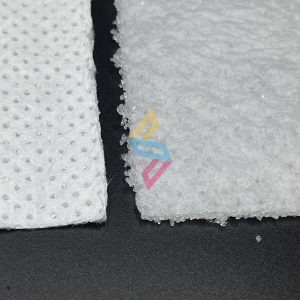There are many Absorbent materials that are known for water-absorbing materials ability to absorb liquids. Liquid Absorbing Substances: Sodium Polyacrylate-CAS No.:9003-04-7
Here are some common examples:

Liquid absorbent material types
- Polyacrylate polymers (Superabsorbent polymers):
Polymer absorbent material are commonly used in disposable diapers and sanitary pads due to their high absorbency and ability to retain large amounts of liquid.
- Sodium polyacrylate: Similar to polyacrylate polymers, sodium polyacrylate is used in many absorbent products such as diapers, sanitary napkins, and wound dressings.

- Cotton: Cotton is a natural fiber that has good absorbent properties, which is why liquid absorbing substances often used in towels, bed linens, and clothing items like socks.
- Cellulose-based materials: Materials like paper towels, tissues, and some types of sponges are made from cellulose fibers, water absorbing materials can absorb liquids effectively.
- Zeolite: Zeolites are minerals that can absorb liquids and gases. Water absorber are used in applications such as water purification and odor control.
- Activated carbon: This is known for its ability to adsorb (not absorb) a wide range of substances, including liquids. Liquid-absorbing substances used in water filtration systems and air purifiers.
- Silica gel: Often found in small packets in products like shoes or electronics packaging, silica gel is a desiccant that can absorb moisture.
- Clay-based materials: Bentonite clay and other similar clays are used in cat litter and certain industrial applications for their absorbent properties.
- Sawdust and wood chips: These natural materials can absorb liquids and are often used in spill cleanup or as bedding for animals.
- Hydrogels: These are networks of polymer chains that can hold a large amount of water or other liquids.
liquid absorbent substance are used in applications like agriculture (for soil moisture retention) and medical dressings.
These water absorbing pellets vary in their properties and applications, but water absorber share the common ability to absorb or adsorb liquids to varying degrees.
Traditional Water Absorbing Materials
When thinking about water-absorbing material, several common options might come to mind, such as cotton, napkins, sponges, anhydrous calcium chloride, soda lime, color-changing silica gel, or activated carbon. However, these materials can typically absorb only several times or at most a few dozen times their weight in water. Additionally, many of them will release the absorbed water when subjected to pressure.
The Best Water Absorbing Material: Sodium Polyacrylate-CAS No.:9003-04-7

Is there a superior water-absorbing material that can absorb large amounts of water and retain liquid absorbing substance even under pressure? The answer is yes—sGELSAP odium polyacrylate.
Exceptional Absorption Capacity
Sodium polyacrylate, a type of sodium acrylate polymer, can absorb hundreds of times its weight in water. After absorbing water, liquid absorbing substances transforms into a gel that locks the water securely, even under pressure. This feature distinguishes sodium polyacrylate from traditional water-absorbing materials.
Advantages of Sodium Polyacrylate
High Absorption Capacity: Sodium polyacrylate can absorb about 500-1000 times liquid-absorbing substances weight in water, which is significantly higher than other traditional absorption materials.
Rapid Absorption Rate: This highly absorbent material can absorb water in just a few seconds, making the absorption rate a critical feature for high-performance applications.
Strong Liquid Retention: Sodium polyacrylate has a strong liquid-locking ability, which is why liquid absorbent substance is widely used in diapers and other products requiring efficient water retention.
Non-Toxic: This material is entirely non-toxic and harmless, already used in applications such as artificial vitreous humor and artificial skin.
Environmentally Friendly: Sodium polyacrylate is eco-friendly and can be decomposed into water, carbon dioxide, and ammonia, ensuring minimal environmental impact.
Biodegradable: Over time, sodium polyacrylate can naturally break down in the environment, making it a sustainable choice for applications where environmental safety is a priority.
Next-Generation Gel Sheet: Soft, Cuttable, and 3x More Absorbent Than Paper Towels

When it comes to spills in the kitchen or fluid control in medical settings, traditional paper towels and cloths often fall short—leaving drips behind and absorbing inefficiently. Enter the gel sheet: an innovative material that combines the softness and flexibility of fabric with the superior absorbency of hydrogels, capable of soaking up three times more water-based liquid than paper towels of the same size.
Created using a novel foaming and UV-curing process, this gel sheet features a porous structure that locks in liquid fast. Even when dried, it remains soft, foldable, and easy to cut, offering a fabric-like feel unlike traditional brittle hydrogels.
Ideal for cleaning up not only water or juice but also thick and viscous fluids like syrup or blood, the gel sheet performs exceptionally well. In lab tests, it absorbed nearly 40 mL of blood in under 60 seconds—more than double the capacity of gauze or sanitary pads—with no dripping.
Thanks to its long shelf stability (over one year at room temperature), the gel sheet is a smart choice for kitchens, labs, hospitals, and emergency situations. It also holds potential for advanced applications like menstrual care, surgical wound dressing, and even heavy bleeding control.
Researchers are now working on enhancing its performance—boosting absorbency, reducing costs, increasing durability, and developing reusable or oil-absorbing versions.
This gel sheet could soon become the superior alternative to paper towels, transforming how we manage spills and cleanups in both everyday and professional settings.

